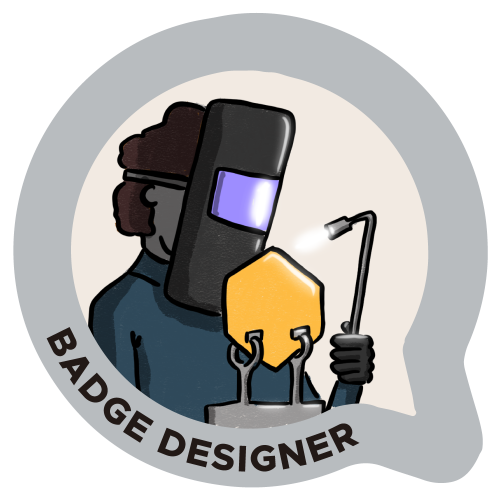Individual Learner, Communities of Practice
cross posted on We Are Open’s blog
Our members are well known for our work on Open Badges, and so we wanted to award badges based on the skills and competencies our intern, Anne, develops during her time with us. Although we outlined some ideas of potential badges before she joined us, we had a hunch that reflective badging, (e.g. awarding assessments based on her as an individual and needs for her future references) would be more beneficial than creating badges in advance.

We Are Open has been all about badges lately! Not only have we been working with Participate on the Keep Badges Weird social learning experience, we’ve also been co-creating badges with Anne. This post outlines how we’ve approached each of these.
Co-creating and self awarding badges for our intern
In a recent episode of the Tao of WAO podcast, Doug and Laura discussed the value of self-awarding badges. We’ve found that speaking with learners when they are especially motivated or encouraged provides valuable insight into the challenges that person might be experiencing. Self-awarded badges are an opportunity to endorse a learner’s reflective insight as something that provided value to the issuer. They also allow for iteration of the credentials themselves.
Based on the badges we’d outlined, for example, Anne awarded herself three of the six first-month badges we thought of in advance. She convinced us to combine badges, pointing out that our initial ideas were too “micro” and that that level of granularity wasn’t as valuable to her.
Anne also awarded herself a “Shadow Jumping” badge, something we wouldn’t have thought of ourselves!
Description: This badge is issued to people who have “gotten over themselves”. This badge is issued to people who have messaged the entire organization, commented on other people’s work, written public blog posts and otherwise shown that they trust their own instincts and voice.
Criteria: The earner can self-assign this badge when they start to feel like a part of their organization.
Anne reflected that her hesitancy to “jump over one’s own shadow” is partially shaped by growing up in a patriarchy. Indeed, women (as well as non-binary folks) often learn from a young age to be more restrained, to not trust their own decisions and be doubtful about their voice. Another aspect of her reflection was that traditional schooling and “normal” work environments reassert hierarchical modes of thinking that seem antithetical to “openness”. Both of these reflections led us to think about how Badges are a great way to work against learned patterns. As we co-create badges, we are also helping the learner to reflect on patterns in society that influence their behaviours.
The value of co-creating badges with the learner is that badges can be shaped to the needs of the outcome. Learners might expect something outside of the learning objectives a creator attaches to an internship or other learning content. As goals are individual and often intrinsic — focusing on the learners requires co-creation together with them.
Co-creation in Communities of Practice
In the Keep Badges Weird community, we are beginning to badge what are called “Value Cycles”. The idea is that activities that happen within communities that are useful to others, and as people participate in these activities, they are creating value for themselves, others and the community at large. We’re particularly interested in the intersection from co-creation and collaboration in a community to being recognised for that co-creation.
This exploration is front and center in the Keep Badges Weird community, with learning activities for people who are Badge Curious and for those who wish to learn more about Value Cycles in Communities of Practice (e.g. CoP Curious). The Value Creator activity goes straight to the heart of what it means to be a community member and asks the learner to be useful in a community they are interested in. As with our intern’s “Shadow Jumping” badge, we’re asking people to step outside of a learned behaviour (i.e. waiting to be called on before speaking up or to be invited into a community)..
We don’t know what kind of conversations will start to emerge when people start to contribute and co-create, but we’re interested to find out! Come on the Keep Badges Weird journey with us. Earn the badges we’ve already established and co-create badges together alongside other community members by building your own badges.
Conclusion
The great thing about badges is that they can recognise behaviours that just aren’t within the usual domain of we call ‘credentials’. In addition, not only is there a huge amount of value in recognising these behaviours, but also in badges providing a motivational element for individuals who might want to display that behaviour.
Our examples in this post cover behaviours relating to confidence and working openly, but badging can work for almost any kind of pro-social behaviour. For example, it’s World Kindness Day later this week, and kindness is definitely something we should recognise!
Next steps
Questions? Ideas? An anecdote about badges in your Community of Practice? Start a discussion, we’re learners here too.
Thanks to Anne Hilliger & Doug Belshaw for all their help on this post!